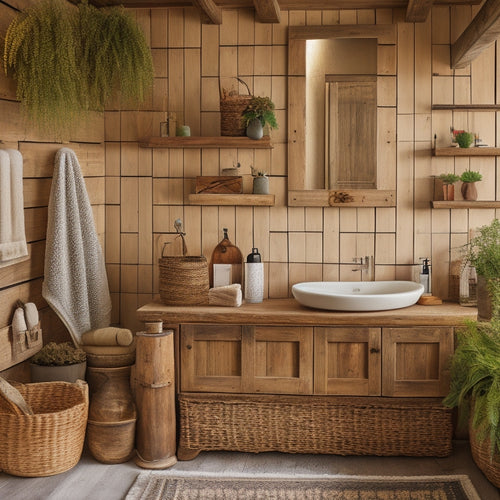
DIY Guide: Crafting a Kids' Toy Chest
Share
Crafting a kids' toy chest is a DIY project that requires precision and attention to detail. Begin by gathering essential tools, including a drill, Kreg Jig, miter saw, table saw, and tape measure. Next, build the toy chest frame by cutting and attaching the bottom piece to the backside, followed by the sides and front board. Assemble the upper section of storage and finish with the front piece. Finally, focus on assembling the storage components, ensuring secure attachment and customization options. With careful planning and execution, you'll create a functional and organized space that sparks imagination and joy - and there's more to discover in the finer details.
Key Takeaways
• Assemble essential tools and materials, including a drill and 4x8-3/4 plywood sheet, for a smooth workflow and quality project.
• Build the toy chest frame by cutting and attaching the bottom, sides, and front pieces using 1 1/4 pocket hole screws.
• Assemble storage components, such as shelves and dividers, with precision and attention to detail for a functional and organized space.
• Ensure secure attachment of storage components using appropriate screws and fasteners to prevent accidents and mishaps.
• Add personalized touches, such as decorative hardware and custom painting, to create a unique and kid-friendly toy chest.
Gathering Essential Tools and Materials
To begin on this project, you'll need to assemble a collection of essential tools and materials. This includes a drill, Kreg Jig, miter saw, table saw, and tape measure, alongside a 4x8-3/4 plywood sheet and 1 1/4 pocket hole screws.
Effective tool organization is important to guarantee a smooth workflow. Material selection is also critical, as it directly impacts the project's overall quality and durability.
When planning your budget, consider the cost of tools and materials, as well as potential safety precautions, such as protective gear and a well-ventilated workspace.
Building the Toy Chest Frame
With the necessary tools and materials at hand, the focus shifts to constructing the toy chest frame, a process that demands meticulous attention to detail and precise cuts to guarantee a sturdy and functional storage unit.
| Step | Description |
|---|---|
| 1 | Cut and attach bottom piece to backside using 1 1/4 pocket hole screws |
| 2 | Attach sides with pocket hole screws |
| 3 | Attach front board to sideboards |
| 4 | Assemble upper section of storage |
| 5 | Finish by attaching front piece |
To secure a robust frame, follow the cut list and cut all pieces to the specified dimensions using a miter saw and/or table saw. Consider incorporating decorative hardware to add a touch of elegance. Later, you can explore various painting techniques to match your child's unique style. By following these steps, you'll create a sturdy toy chest frame that will withstand years of play.
Assembling the Storage Components
As the toy chest frame takes shape, attention turns to assembling the storage components, where precision and careful attention to detail are essential in creating a functional and organized space for your child's treasured belongings.
Here, you'll attach the shelves, dividers, and compartments that will keep toys and accessories neatly stored. Consider design customization options, such as adjustable shelves or removable bins, to tailor the storage to your child's unique needs.
Safety precautions are vital, so make sure all components are securely attached and won't topple or pinch tiny fingers.
Frequently Asked Questions
How Do I Ensure Accurate Measurements With My Tape Measure?
'Measuring mistakes - the DIY nemesis. Guarantee accuracy by calibrating your tape measure regularly and avoiding measurement shortcuts, like relying on mental math or eyeballing it, to secure precise results in your project.'
Can I Use Alternative Screw Types Instead of Pocket Hole Screws?
When considering screw alternatives, explore drive types such as hex, Phillips, or square to guarantee compatibility with your drill. However, pocket hole screws' unique design provides maximum holding power, making them ideal for this project's joint requirements.
What Safety Precautions Should I Take When Operating Power Tools?
Using power tools is like steering through a stormy sea - one misstep can prove disastrous. Don safety goggles to shield your eyes from debris and wear ear protection to muffle the cacophony, ensuring a safe and successful voyage.
How Do I Avoid Splintering When Cutting Plywood?
When cutting plywood, avoid splintering by selecting higher Plywood grades with denser wood fibers and employing precise Cutting techniques, such as using a sharp blade, maintaining a consistent feed rate, and applying gentle to moderate pressure.
Can I Stain or Paint the Toy Chest After Assembly?
When considering post-assembly staining or painting, guarantee a smooth finish by selecting suitable color options and finish types, such as water-based stains or low-VOC paints, to complement the toy chest's design and durability.
Related Posts
-

Rustic Bathroom Storage Under $100
You can easily boost your bathroom's charm and functionality with rustic storage solutions under $100. Consider using...
-

Industrial Bathroom Cabinet With Vintage Faucets
You're creating a unique industrial bathroom cabinet with vintage faucets that exudes rustic charm and sophistication...
-

RADICAL HEALTH REVOLUTION: Blueprint for Eternal Wellness
I've spent years feeling stuck, searching for a way to break free from mediocre health and access a life of vibrancy ...


